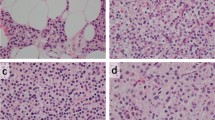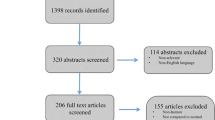Abstract
Secretoglobins are small secreted proteins, the expression of which has mostly been associated with secretory mucosal epithelia. Several secretoglobins have been implicated in the development of various human cancers. Allelic deletions of chromosome 11q13 correlates with the invasiveness of pituitary tumors. Intriguingly, several secretoglobin genes are located on 11q13; however, for most of these genes the expression in the pituitary and pituitary tumors have not been investigated. Antibodies specific for the secretoglobin lipophilin B (SCGB1D2, BU101) were developed and used in an immunohistochemical analysis of a human normal tissue microarray. Prominent lipophilin B immunoreactivity was found in the secretory cells of the anterior pituitary. Eight of nine analyzed pituitary adenomas showed a reduction in lipophilin B immunoreactivity compared to normal pituitary. However, there was no apparent association between lipophilin B immunoreactivity and hormone production or tumor invasiveness. Expression of eight different secretoglobin mRNAs were analyzed in normal pituitary and the pituitary adenoma cell line HP75 by highly specific quantitative real-time reverse transcription-PCR assays. Lipophilins B and C (SCGB2A1, mammaglobin B) were the most prominently expressed secretoglobin mRNAs in the pituitary. No secretoglobin mRNA was detected in the HP75 cells. The present report demonstrates, for the first time, lipophilin B expression in the pituitary and its apparent down-regulation in pituitary adenomas.


Similar content being viewed by others
References
Adib TR, Henderson S, Perrett C, Hewitt D, Bourmpoulia D, Ledermann J, Boshoff C (2004) Predicting biomarkers for ovarian cancer using gene-expression microarrays. Br J Cancer 90:686–692
Austin CJ, Emberson L, Nicholls P (2004) Purification and characterization of pheromaxein, the porcine steroid-binding protein. A member of the secretoglobin superfamily. Eur J Biochem 271:2593–2606
Bates AS, Farrell WE, Bicknell EJ, McNicol AM, Talbot AJ, Broome JC, Perrett CW, Thakker RV, Clayton RN (1997) Allelic deletion in pituitary adenomas reflects aggressive biological activity and has potential value as a prognostic marker. J Clin Endocrinol Metab 82:818–824
Becker RM, Darrow C, Zimonjic DB, Popescu NC, Watson MA, Fleming TP (1998) Identification of mammaglobin B, a novel member of the uteroglobin gene family. Genomics 54:70–78
Broeckaert F, Clippe A, Knoops B, Hermans C, Bernard A (2000) Clara cell secretory protein (CC16): features as a peripheral lung biomarker. Ann N Y Acad Sci 923:68–77
Carter D, Douglass JF, Cornellison CD, Retter MW, Johnson JC, Bennington AA, Fleming TP, Reed SG, Houghton RL, Diamond DL, Vedvick TS (2002) Purification and characterization of the mammaglobin/lipophilin B complex, a promising diagnostic marker for breast cancer. Biochemistry 41:6714–6722
Carter D, Dillon DC, Reynolds LD, Retter MW, Fanger G, Molesh DA, Sleath PR, McNeill PD, Vedvick TS, Reed SG, Persing DH, Houghton RL (2003) Serum antibodies to lipophilin B detected in late stage breast cancer patients. Clin Cancer Res 9:749–754
Colpitts TL, Billing-Medel P, Friedman P, Granados EN, Hayden M, Hodges S, Menhart N, Roberts L, Russell J, Stroupe SD (2001) Mammaglobin is found in breast tissue as a complex with bu101. Biochemistry 40:11048–11059
Klug J, Beier HM, Bernard A, Chilton BS, Fleming TP, Lehrer RI, Miele L, Pattabiraman N, Singh G (2000) Uteroglobin/Clara cell 10-kDa family of proteins: nomenclature committee report. Ann N Y Acad Sci 923:348–354
Knosp E, Steiner E, Kitz K, Matula C (1993) Pituitary adenomas with invasion of the cavernous sinus space: a magnetic resonance imaging classification compared with surgical findings. Neurosurgery 33:610–617; discussion 617–618
Krop IE, Sgroi D, Porter DA, Lunetta KL, LeVangie R, Seth P, Kaelin CM, Rhei E, Bosenberg M, Schnitt S, Marks JR, Pagon Z, Belina D, Razumovic J, Polyak K (2001) HIN-1, a putative cytokine highly expressed in normal but not cancerous mammary epithelial cells. Proc Natl Acad Sci USA 98:9796–9801
Lehrer RI, Xu G, Abduragimov A, Dinh NN, Qu XD, Martin D, Glasgow BJ (1998) Lipophilin, a novel heterodimeric protein of human tears. FEBS Lett 432:163–167
Marchetti A, Barassi F, Martella C, Chella A, Salvatore S, Castrataro A, Mucilli F, Sacco R, Buttitta F (2004) Down regulation of high in normal-1 (HIN-1) is a frequent event in stage I non-small cell lung cancer and correlates with poor clinical outcome. Clin Cancer Res 10:1338–1343
Mukherjee AB, Kundu GC, Mantile-Selvaggi G, Yuan CJ, Mandal AK, Chattopadhyay S, Zheng F, Pattabiraman N, Zhang Z (1999) Uteroglobin: a novel cytokine? Cell Mol Life Sci 55:771–787
Ni J, Kalff-Suske M, Gentz R, Schageman J, Beato M, Klug J (2000) All human genes of the uteroglobin family are localized on chromosome 11q12.2 and form a dense cluster. Ann N Y Acad Sci 923:25–42
Nieto A, Ponstingl H, Beato M (1977) Purification and quaternary structure of the hormonally induced protein uteroglobin. Arch Biochem Biophys 180:82–92
Niimi T, Keck-Waggoner CL, Popescu NC, Zhou Y, Levitt RC, Kimura S (2001) UGRP1, a uteroglobin/Clara cell secretory protein-related protein, is a novel lung-enriched downstream target gene for the T/EBP/NKX2.1 homeodomain transcription factor. Mol Endocrinol 15:2021–2036
Peri A, Cordella-Miele E, Miele L, Mukherjee AB (1993) Tissue-specific expression of the gene coding for human Clara cell 10-kD protein, a phospholipase A2-inhibitory protein. J Clin Invest 92:2099–2109
Sjodin A, Guo D, Hofer PA, Henriksson R, Hedman H (2003) Mammaglobin in normal human sweat glands and human sweat gland tumors. J Invest Dermatol 121:428–429
Sjodin A, Guo D, Sorhaug S, Bjermer L, Henriksson R, Hedman H (2003) Dysregulated secretoglobin expression in human lung cancers. Lung Cancer 41:49–56
Stripp BR, Lund J, Mango GW, Doyen KC, Johnston C, Hultenby K, Nord M, Whitsett JA (1996) Clara cell secretory protein: a determinant of PCB bioaccumulation in mammals. Am J Physiol 271:L656–664
Watson MA, Fleming TP (1994) Isolation of differentially expressed sequence tags from human breast cancer. Cancer Res 54:4598–4602
Watson MA, Fleming TP (1996) Mammaglobin, a mammary-specific member of the uteroglobin gene family, is overexpressed in human breast cancer. Cancer Res 56:860–865
Watson MA, Dintzis S, Darrow CM, Voss LE, DiPersio J, Jensen R, Fleming TP (1999) Mammaglobin expression in primary, metastatic, and occult breast cancer. Cancer Res 59:3028–3031
Weeraratna AT, Cajigas JA, Schwartz A, Enquist EG, Manyak MJ, Patierno SR (1997) Loss of uteroglobin expression in prostate cancer: relationship to advancing grade. Clin Cancer Res 3:2295–2300
Acknowledgements
This work was supported by grants from the Cancer Research Foundation in Northern Sweden and the Swedish Cancer Society. We thank Kerstin Bergh for help with the immunohistochemistry, and Mikael Kimdal for help with the recombinant proteins.
Author information
Authors and Affiliations
Corresponding author
Rights and permissions
About this article
Cite this article
Sjödin, A., Guo, D., Lund-Johansen, M. et al. Secretoglobins in the human pituitary: high expression of lipophilin B and its down-regulation in pituitary adenomas. Acta Neuropathol 109, 381–386 (2005). https://doi.org/10.1007/s00401-004-0972-6
Received:
Revised:
Accepted:
Published:
Issue Date:
DOI: https://doi.org/10.1007/s00401-004-0972-6




